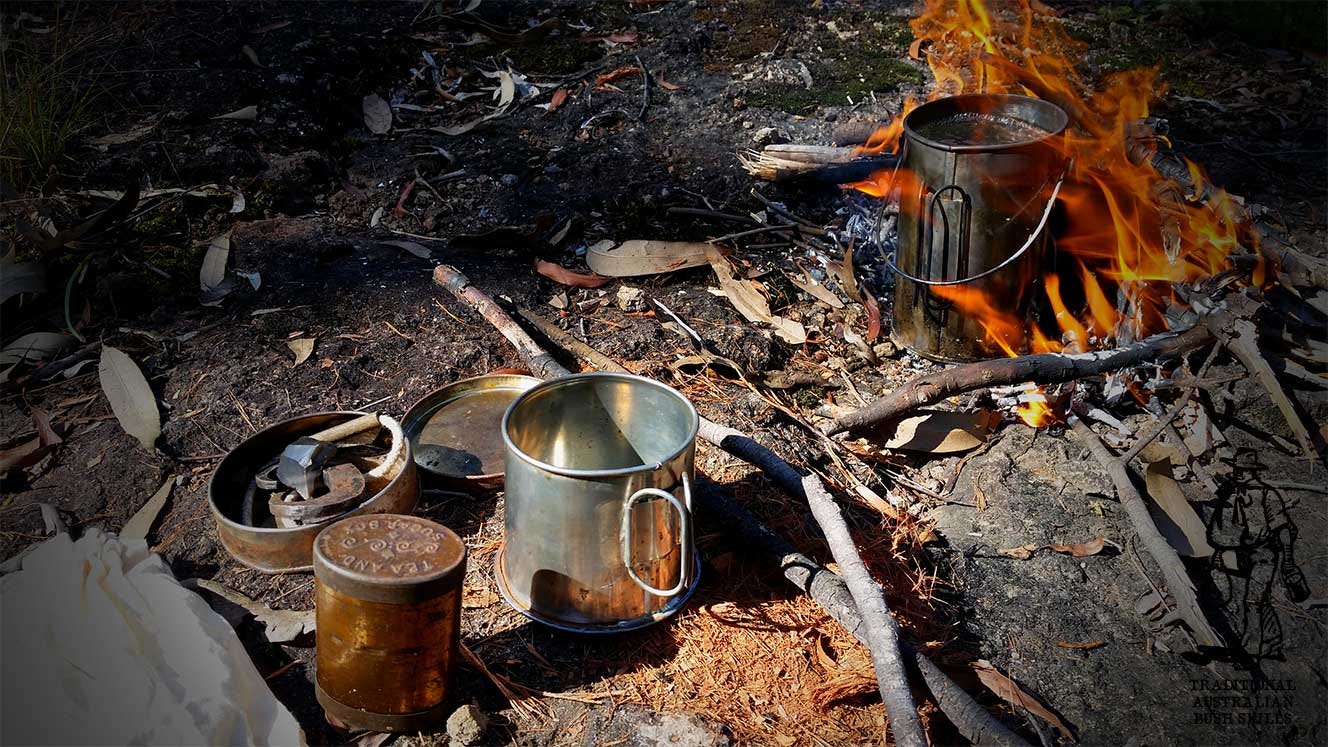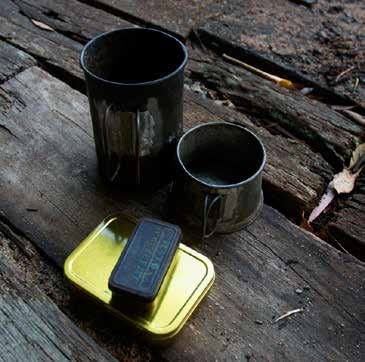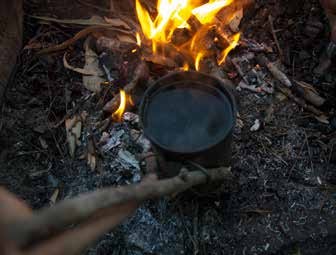The Forgotten Lore of the Quart Pot and Pannikin
Rediscovering the billycan's more useful little brother

The humble quart pot is just about due a popular revival I reckon. Of course there are plenty of old bushies out there who use and swear by the quart pot and always have, so this article will probably include nothing new for them.
If you’ve never seen one, you may be asking “So what is a quart pot?” Well, the quart pot and its smaller cousin the pint pot are little more than a small billycan with folding wire handles on the sides and a companion cup, called a pannikin, which fits into the pot as a lid. They come in a variety of configurations; oval, round, “D”- shaped and even roughly rectangular. They come in various sizes - one Imperial Quart or one Imperial Pint, and to confuse the issue, sometimes the pot part is called the “quart” and the pannikin a “pint”. To further muddy the waters, some folks out west call the quart pot a “Bush Pot”. At the end of the day it doesn’t really matter what you call it.
Traditionally the quart pot was made from tin-plated sheet iron or from copper, but nowadays you can find also them in stainless steel, like the Ord River brand Quart Pot. Stockmen carried them strapped to the side of the saddle in a leather cover, while swaggies and others used canvas covers or even calico bags to carry their quart pots. Like a billy can, the quart pot will leave soot all over the inside of a pack or your swag’s nose bag if it’s not covered.
The advantages of the quart pot are many, but here are a few of them:
It is a pot and pannikin combined;
There’s room inside for tea, sugar, matches, a spoon and some tinder;
Anything stored inside the quart pot can be kept waterproof very easily;
It has two handles, one across the top and one at the side, both folding. Some have a bail handle like a billy as well;
The round pots are wider at the base than they are at the top so they are stable on the fire;
It sits in the fire and the flames lick around it, so no props or tripods are needed; and
Best of all... it boils very quickly!
Before the seamless, drawn stainless steel quart pots became available, the most common option was a tinware quart pot with soldered seams. These required “seasoning” as well as a fair bit of care before, during and after use since tinware is very susceptible to rust.

Seasoning Tinware
Just like cast ironware, tinware should be seasoned before first use. This seasoning is purely designed to protect the tin from rust. If not seasoned, tinware will rust rapidly at the seams due to dissimilar metals, the tin plating and the iron, touching in the presence of water. This phenomenon is called galvanic corrosion and it’s the reason why food tins are usually sealed inside with a layer of plastic and outside with a layer of lacquer.
A quart pot’s sole purpose for being is to boil water, so if you don’t seal it, rust will destroy it quite quickly. The same goes for any other proper tinware, from billycans to survival kit tins, tin tinder boxes or first aid tins.
Seasoning tinware is a really easy procedure, but you have to make sure the tinware doesn’t get hot enough to make the solder flow out of the seams or it will no longer be water tight.
Step 1 - rub the quart pot and pannikin all over, inside and out, with lard, animal fat or even with butter if that’s all you have in the house.
Step 2 - place in the oven on a medium heat and keep a close watch until the lard or fat flows into a liquid state. Remove from heat immediately.
Step 3 - Rub the melted fat all over the quart pot and pannikin with a cloth to ensure complete coverage.
Step 4 - Wash with hot water and dry completely.
The fat will have completely penetrated any microscopic flaws in the tin-plating while also sealing the seams against the entry of water. Normal soap and water will not wash the fat out of these tiny nooks and crannies, and the amount of fat left in is not enough to impart an unpleasant taste to any water boiled in the quart pot.
Although the seasoning will last quite a long time, it’s always a good idea to re-season a few times a year after heavy use, just to be on the safe side.
Preventing Rust
After you’ve used the tinware quart pot and pannikin, always dry them completely. Never leave water sitting in the pot or pannikin for any length of time or rust will develop in the seams regardless of seasoning. Best method of drying is to dry off with a cloth then use heat and flame to drive off any residual moisture inside, taking care that the tin doesn’t get hot enough for the solder to run.
If rust does develop inside the quart pot or pannikin, then don’t try and scour it off, instead, just fill the quart pot with hot vinegar. Left for a few hours, the vinegar will kill the rust. Wash out the vinegar very thoroughly and dry the pot and pannikin as normal using heat to drive off the residual moisture.
If you have a stainless steel Ord River Quart Pot, then you have nothing to worry about when it comes to rust.
How to Use the Quart Pot
Despite being mainly used to boil water for tea or coffee, the quart pot is a good pot for boiling rice, pasta, small tins of food, MRE sachets or other wet-prep foods and the pannikin makes a nice bowl, if a little small.
While a billycan is often sat directly on the fire or suspended above it, the quart pot is most effective when pushed into the fire from the side so that the wind will carry the flames around it.
The tinware quart pots require a little special handling while in use. It’s important that the pot be put on the fire absolutely filled to the brim with water. This is for a couple of reasons - so filled, a quart pot can be removed by an experienced quart pot user, from the fire by grasping the rolled top edge of the pot. This is not recommended, but it’s a much-loved old timer method. When the water level is at the very top, it prevents the rolled edge from being heated directly by the flames, and since the rolled edge dissipates heat quickly, anyone with a rock steady hand can use it to remove the quart pot from the fire. If the water level in the pot is too low, then burns will result from the hot rim. If the water level is too high, then scalds from the rolling-boiling water will be the likely result. Another reason why the old timers always filled the quart pot to the brim was to avoid burning the rim off the quart pot. Over a period of a few years, the tinplate will eventually melt off that part of a quart pot above the fill level which allows it to rust and then deteriorate even further.
Pushing the quart pot into the fire ensured that the greater surface area of the side of the pot was exposed to the heat and flames, while the folding handles of the pot remained out of the heat as far as possible.
To make the pot boil faster, a quart pot was never cleaned on the outside, the theory being that the soot on the exterior of the pot, being black, would cause the pot to heat up more quickly and to retain its heat for longer than the shiny surface of a cleaned one. Makes sense to me. This is the reason why the quart pot should be carried in a cover or at least a cotton bag.
Despite all efforts to avoid it, the wire handles of the quart pot can become too hot to touch. If they weren’t confident grabbing the pot by the brim, or if some of the water had slopped out, the old timers wouldn’t mess around trying to use a handkerchief or similar. They simply used a pair of sticks to remove the hot quart pot from the fire. To do this, simply put a stick through each handle and cross them. The friction holds the pot securely as you remove it from the fire. Incidentally, the same technique can work with a cups canteen with “butterfly” pattern handles. These can also become too hot to touch at times.
The old timers had a thing about smoke from the fire tainting the flavour of their tea. Since the quart pot is boiled uncovered, the smoke could well get into the water and taint the tea I suppose. It hasn’t been a problem for me, but the old timers came up with a method to stop the problem. They’d simply place crossed twigs onto the pot and relax, content in the knowledge that their tea would taste like stale old ration tea rather than wattle, she-oak or eucalyptus smoke. Incidentally the placing of sticks on the pot has a verified purpose. It works well to stop a pot or billy boiling over.
With the stainless steel Ord River offering cornering the market, it’s hard to find a proper tinware quart pot and pannikin these days. I would not recommend looking for and using a vintage quart pot. These were, without exception, soldered with lead solder which makes them unsafe to use.

Until recently, the “bush outfitter” for rich cityfolk, RM Williams, sold both tinware and copper quart pots. The copper ones are a beautiful piece of equipment, but I went for the tinware Beltana quart pot. This is a round cross-section pot made by RM Williams’ son John, who is a talented tinsmith making his quart pots in the old way by hand, but using food-safe lead-free solder. The Beltana Pot is very similar to the vintage one in the pictures which accompany this article, just a little bigger and has a bail handle for use with a billy ring and tripod if required. It’s the same pattern as the pots originally made on Beltana Station in South Australia.

There is a reportedly Australian-made oval cross section quart pot available from Kingston Horse Supplies which looks pretty good, although I have no direct experience with it. Just be aware that if you get yourself a tinware quart pot you’ll have to maintain and look after it to keep the rust at bay. If this sounds like too much trouble, then don’t despair, there’s always the stainless Ord River quart pot.
You can also make or purchase covers for the quart pots. There are leather ones available for the Ord River pot designed to be strapped to a saddle, at a reasonable price, and RM Williams also supplies a good leather quart pot case called a Bush Pot case. Of course, this costs a couple of hundred dollars more than the Ord River case.
I personally consider the leather cases to be horse tack rather than proper bush gear for on-foot adventuring so I simply carry mine in a calico flour bag inside my pack or swag’s dilly bag. A nylon drawstring bag would work just as well, and it is simple to make your own traditional style case out of leather or canvas or a combination of the two.






